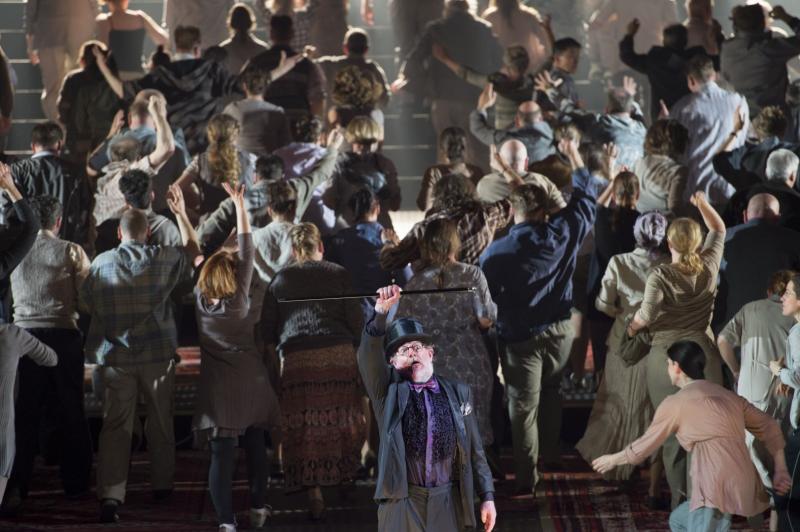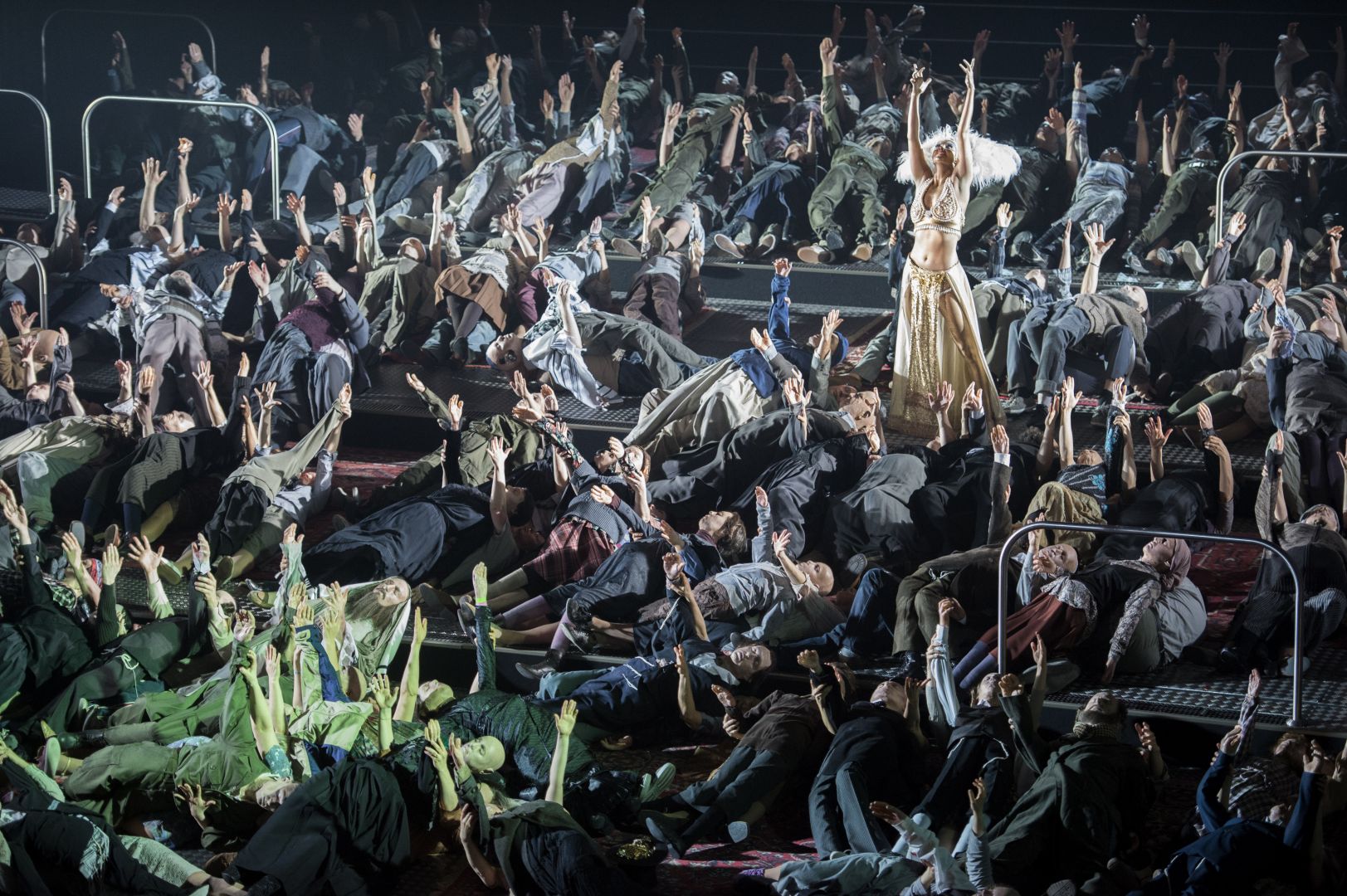Moses und Aron, Komische Oper Berlin, OperaVision review – complex and powerful memorial | reviews, news & interviews
Moses und Aron, Komische Oper Berlin, OperaVision review – complex and powerful memorial
Moses und Aron, Komische Oper Berlin, OperaVision review – complex and powerful memorial
Schoenberg’s opera of unanswerable questions proves a fitting Holocaust epitaph

Barrie Kosky’s production of Moses und Aron was staged at the Komische Oper Berlin in 2015 to mark the 70th anniversary of the liberation of Auschwitz. Schoenberg’s opera is philosophical and open to a variety of interpretations.
The production is dominated by the huge chorus, who are onstage almost throughout. The set is simple, a shallow ascending terrace, but it is also small and narrow, with a low ceiling. That gives a sense of claustrophobia, but even within these space limits, the singers move continuously, usually as a single unit—the “people” whom Moses must convince to leave Egypt. The chorus is the star of this production, their singing excellent, and their movements gracefully choreographed throughout.
The two main characters, Moses and Aron, are presented in a variety of guises, and Kosky’s clear vision for the chorus is less in evidence here. The staging begins in silence, with lines from Waiting for Godot projected on the backdrop. And when Moses and Aron appear, they resemble Vladimir and Estragon. This is presumably intended to bring some dark comedy to the proceedings, and to highlight the Moses’ initial indecision about how he must act, but the comparison soon wears thin. Fortunately, Kosky has another entertaining idea to follow, turning Aron into a conjurer and Moses into his straight man accomplice. This is a better fit for the story, the magic tricks that Aron pulls a graphic parallel for his efforts to convince the people of Moses’ message. Tenor John Daszak is impressive as Aron. He was a late addition to an otherwise rigorously rehearsed production, but it doesn’t show. Vocally, he is on top of the demanding role. Some of the high notes are strained, but that tension fits the drama. He is also good at the magic tricks – the camera close-ups sometimes give away the sleight of hand, but no matter.  Where other productions focus equal attention on the two main roles, Moses is portrayed here as a more subsidiary character. That fits the musical portrayal, as the role is written in Sprechstimme – somewhere between singing and speech. Robert Hayward (delivers the part in a gruff, veiled tone, in stark but effective contrast to Daszak’s more lyrical Aron.
Where other productions focus equal attention on the two main roles, Moses is portrayed here as a more subsidiary character. That fits the musical portrayal, as the role is written in Sprechstimme – somewhere between singing and speech. Robert Hayward (delivers the part in a gruff, veiled tone, in stark but effective contrast to Daszak’s more lyrical Aron.
In the second act, the focus moves from Moses and Aron to the chorus, with the notorious Golden Calf scene. Kosky presents the scene as a complex allegory. Burlesque dancers, painted in gold, are filmed from stage right with an old-fashioned cinema camera, operated by dwarf actors dressed as Marx and Herzl. Meanwhile, the chorus hold up life-sized dummies, clearly identified as Jews. The scene culminates with the dummies thrown onto a pile, which then stands in for Mount Horeb, from which Moses descends. The opera is unfinished, and this production presents the score as Schoenberg left it, without a third act. But it feels complete for the sheer visual power of this second act conclusion, whatever message Kosky is trying to convey.
Moses und Aron was an unusual, and expensive, choice for a company more accustomed to operetta, and although it was well received, Kosky made clear at the time that there was no prospect of a revival. So this online video is especially valuable. The camerawork is often busy, with a lot of closeups, and occasional cutaways to details in the crowd, but that only emphasises the claustrophobia of the staging. Sound quality is excellent, with the orchestral lines immediate and clearly delineated. Credit for that should also go to conductor Vladimir Jurowski, sometime Music Director of the Komische Oper, returning here after a long absence. Jurowski brings his trademark clarity and focus, and the orchestra plays magnificently for him, the precision and detail of the music a fitting complement to studied abstraction of Kosky’s vision.
Watch the production on OperaVision's YouTube channel. English captioning available.
rating
Explore topics
Share this article
The future of Arts Journalism
You can stop theartsdesk.com closing!
We urgently need financing to survive. Our fundraising drive has thus far raised £49,000 but we need to reach £100,000 or we will be forced to close. Please contribute here: https://gofund.me/c3f6033d
And if you can forward this information to anyone who might assist, we’d be grateful.

Subscribe to theartsdesk.com
Thank you for continuing to read our work on theartsdesk.com. For unlimited access to every article in its entirety, including our archive of more than 15,000 pieces, we're asking for £5 per month or £40 per year. We feel it's a very good deal, and hope you do too.
To take a subscription now simply click here.
And if you're looking for that extra gift for a friend or family member, why not treat them to a theartsdesk.com gift subscription?
more Opera
 Albert Herring, English National Opera review - a great comedy with depths fully realised
Britten’s delight was never made for the Coliseum, but it works on its first outing there
Albert Herring, English National Opera review - a great comedy with depths fully realised
Britten’s delight was never made for the Coliseum, but it works on its first outing there
 Carmen, English National Opera review - not quite dangerous
Hopes for Niamh O’Sullivan only partly fulfilled, though much good singing throughout
Carmen, English National Opera review - not quite dangerous
Hopes for Niamh O’Sullivan only partly fulfilled, though much good singing throughout
 Giustino, Linbury Theatre review - a stylish account of a slight opera
Gods, mortals and monsters do battle in Handel's charming drama
Giustino, Linbury Theatre review - a stylish account of a slight opera
Gods, mortals and monsters do battle in Handel's charming drama
 Susanna, Opera North review - hybrid staging of a Handel oratorio
Dance and signing complement outstanding singing in a story of virtue rewarded
Susanna, Opera North review - hybrid staging of a Handel oratorio
Dance and signing complement outstanding singing in a story of virtue rewarded
 Ariodante, Opéra Garnier, Paris review - a blast of Baroque beauty
A near-perfect night at the opera
Ariodante, Opéra Garnier, Paris review - a blast of Baroque beauty
A near-perfect night at the opera
 Cinderella/La Cenerentola, English National Opera review - the truth behind the tinsel
Appealing performances cut through hyperactive stagecraft
Cinderella/La Cenerentola, English National Opera review - the truth behind the tinsel
Appealing performances cut through hyperactive stagecraft
 Tosca, Royal Opera review - Ailyn Pérez steps in as the most vivid of divas
Jakub Hrůša’s multicoloured Puccini last night found a soprano to match
Tosca, Royal Opera review - Ailyn Pérez steps in as the most vivid of divas
Jakub Hrůša’s multicoloured Puccini last night found a soprano to match
 Tosca, Welsh National Opera review - a great company reduced to brilliance
The old warhorse made special by the basics
Tosca, Welsh National Opera review - a great company reduced to brilliance
The old warhorse made special by the basics
 BBC Proms: The Marriage of Figaro, Glyndebourne Festival review - merriment and menace
Strong Proms transfer for a robust and affecting show
BBC Proms: The Marriage of Figaro, Glyndebourne Festival review - merriment and menace
Strong Proms transfer for a robust and affecting show
 BBC Proms: Suor Angelica, LSO, Pappano review - earthly passion, heavenly grief
A Sister to remember blesses Puccini's convent tragedy
BBC Proms: Suor Angelica, LSO, Pappano review - earthly passion, heavenly grief
A Sister to remember blesses Puccini's convent tragedy
 Orpheus and Eurydice, Opera Queensland/SCO, Edinburgh International Festival 2025 review - dazzling, but distracting
Eye-popping acrobatics don’t always assist in Gluck’s quest for operatic truth
Orpheus and Eurydice, Opera Queensland/SCO, Edinburgh International Festival 2025 review - dazzling, but distracting
Eye-popping acrobatics don’t always assist in Gluck’s quest for operatic truth
 MARS, Irish National Opera review - silly space oddity with fun stretches
Cast, orchestra and production give Jennifer Walshe’s bold collage their all
MARS, Irish National Opera review - silly space oddity with fun stretches
Cast, orchestra and production give Jennifer Walshe’s bold collage their all

Add comment